Bethel Community Cemetery
The 1854 cemetery reveals a panoramic view of Bethel Community. This burial ground is the location of the gravesite of Inman of Cold Mountain fame as well as of other historic figures from Bethel Community’s past. Visitors with the Cold Mountain Heritage Driving Tour CD learn the long-secret place of Inman’s grave location as well as the haunting details of his demise on Big Stomp Mountain and subsequent burial by his father. Books 1 and 5 of Legends, Tales & History of Cold Mountain relay the history. See also Walking in the Footsteps of Those Who Came Before Us DVD and Cold Mountain Heritage Driving Tour CD.
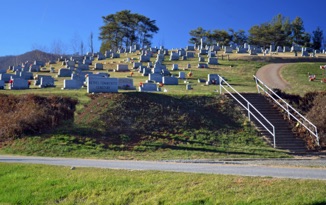
Bethel Presbyterian Church
The Reverend Jesse Stalcup, Baptist minister and millwright, built the building in 1885 as the first Presbyterian Church in Haywood County. The church is Bethel Rural Community Organization’s home base. Floor to ceiling chestnut interior in the sanctuary provides a dramatic backdrop for learning about the history of Presbyterianism in Western North Carolina. Books 1 and 5 of Legends, Tales & History of Cold Mountain inform about the church’s unique past. See also Walking in the Footsteps of Those Who Came Before Us DVD and Cold Mountain Heritage Driving Tour CD. BRCO's Historic Preservation Committee placed its second local historic marker at the church/community center. Artist Nick De Paolo painted a picture of the original white clapboard church that is included in the Historic Preservation art print collection.
Blanton/Reece Log Cabin
Dated to 1821, the structure is considered to be Haywood County’s oldest log cabin. The cabin’s full-dovetail corner mortise is a rare architectural feature of this English-style single-unit with shed addition. This 360 square foot cabin was home to ten members of the Vess and Talitha Reece family from 1925-2001. Book 5 of Legends, Tales & History of Cold Mountain recounts vivid details about the Reece family as captured from the memory of Reece descendants. Speculation about the Blanton heritage is outlined in Book 6 of the Legends series. See also Cold Mountain Heritage Driving Tour CD. Artist Janice Swanger painted a picture of the cabin that is included in the Historic Preservation art print collection.
Captain James Allen and Nancy Louisa Cathey Blaylock House
This house was completed by the Blaylock family, headed by Captain James Allen and his wife Nancy Louisa Cathey Blaylock. Surrounding an 1835 cabin, the combination Queen Anne/Italianate house was begun in 1868 and completed by 1890 for the Civil War captain, his wife, and family. The building housed five generations of the Blaylock family. Stories of buried treasure, a murder, and ghostly voices are detailed in Books 1, 2, & 4 of Legends, Tales & History of Cold Mountain. Current owners have finished the third floor, and the many antiques make the Blaylock House an intriguing place to visit. Artist Wanetta Welch, in 1899, painted a picture of the Blaylock House as it appeared in the 19th Century. The painting is included in the Historic Preservation art print collection.
Joseph Turner and Martha Anna Iva Killian Cathey House
The Joseph Turner and Martha Anna Iva Killian Cathey House is perhaps Bethel's oldest remaining frame structure. Eldest son of Colonel Joseph Cathey (state legislator, mercantile owner, farmer, miller), Joseph Turner Cathey was one of the “Sons of the Pigeon” who formed the Highlanders, Company F, 25th North Carolina Infantry Regiment under Captain Thomas Isaac Lenoir at the outbreak of the Civil War. He perished at Wilson on September 1, 1863. Prior to the war Cathey had commissioned Dred and Willis Blaylock to build the house. The front portion was begun by 1860. After Cathey’s passing, his wife completed the rear section of the house by1864 for herself and her three children. For more information about the Cathey House and family see Legends, Tales & History of Cold Mountain, Books 1, 2, and 3. See also Walking in the Footsteps of Those Who Came Before Us DVD. Artist Jason Hawkins painted a picture of the Cathey House that is included in the Historic Preservation art print collection.
Bethel Cannery
Original planning called for five canning operations located at five Haywood County schools. The program finally settled on four (in the order of initiation): Waynesville, Bethel, Crabtree, and Fines Creek.
Each cannery had a manager who operated under the direction of the local school agricultural teacher. In addition, a hired primary cannery supervisor had oversight over all of the canneries in the county. At Bethel, Mrs. Joe (Tellie) Beverage, Mrs. David (Edith) Edwards, and Mrs. John Nesbitt were alternating chief cannery managers during the years of operation. Agriculture teachers I.A. McLane, R. L. Edwards, and M.C. Nix were technical directors over the Bethel cannery operation. Mrs. Rufus Siler of Waynesville headed the county-wide program.
In Haywood County, all of the cannery facilities were located in school-owned buildings. Typical equipment included the following: tables, chairs, sinks, colanders, empty container handling equipment, canning crates, pressure gauges, pressure relief valves, temperature measuring devices, temperature recorders and controllers, timing devices, filling machines, dispensing machines, pre-cookers, boilers, mechanical hoist, exhaust tunnel, retort equipment, retort controls and instrumentation, steam supply, steam spreaders, safety and pressure relief valves, water retention tank for cooling water, vent piping, water piping and controls, drains, compressed air lines, cans, can lids, conveyors, dispensing machines, weighing machines, sealing equipment, lid crimping equipment, dividers, separators, crates, baskets, trays, stacking racks, post-process handling equipment, and cleaning equipment.
The cannery in Bethel was in operation from 1945-1960. The cannery building still stands on Poindexter Road but is now use for storage by Haywood County Schools.
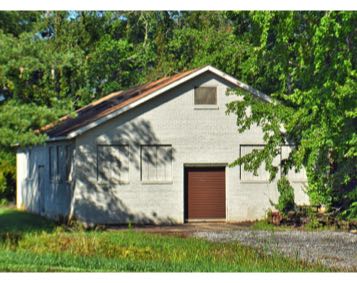
Buck Spring Lodge
In 1896, George Vanderbilt constructed a secluded family retreat that straddled the Haywood/Transylvania County line on a ridgetop abutting Pisgah Mountain. Named Buck Spring Lodge after a nearby gushing mountain stream, the several log structures were connected by breezeways and porches that offered marvelous views of both the French Broad River drainage basin and the East Fork of the Pigeon River Valley. For the next half century, the Vanderbilt family along with friends and guests retreated to Buck Spring Lodge to enjoy the amenities of nature that George Vanderbilt had recognized and appreciated from the beginning. However, in 1961, the Buck Spring Lodge buildings were demolished when the Blue Ridge Parkway was constructed. The lodge site and beautiful vistas remain and can be enjoyed at the Parkway’s milepost 407.6, aptly named Buck Spring Gap Overlook.
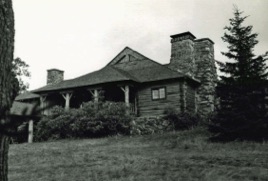
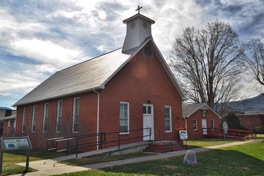



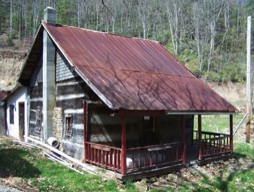


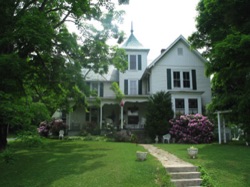







Blaylock House before restoration



Local historic marker placed by BRCO’s Historic Preservation Committee